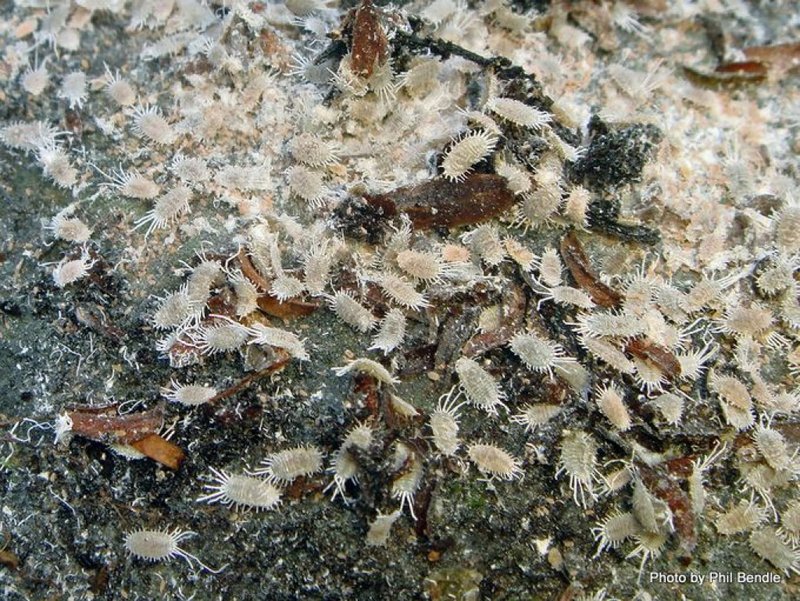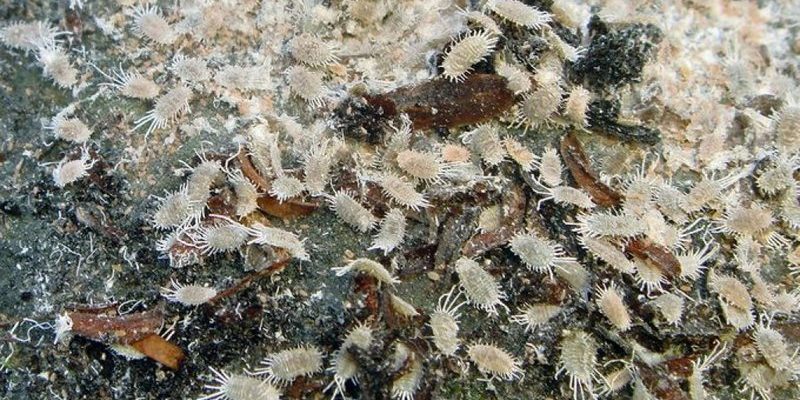
Mealybugs are small, soft-bodied insects that belong to the family Pseudococcidae. They are known for their cottony, waxy appearance—almost like tiny bits of cotton stuck to plants. Imagine seeing a small white fluff on your houseplants; that’s most likely a mealybug making itself at home. These pests are particularly notorious among gardeners and indoor plant enthusiasts because they can quickly invade and damage a variety of plants. You might be wondering how something so tiny can cause so much fuss, right? Well, mealybugs feed on the plant’s sap, which can weaken or even kill the plant over time.
What’s even more fascinating (or alarming, depending on how you look at it) is how mealybugs are often found in groups. They cluster on the stems, leaf axils, and undersides of leaves, creating a sticky mess. This stickiness is due to the honeydew they produce—essentially their waste, which can attract other pests and lead to sooty mold. So, if you’ve ever noticed a plant that seems to have a gooey residue or a blackened appearance, it could very well be a mealybug party going on!
In this article, we’ll dig deeper into the life of mealybugs, their habits, and how you can manage them if they invade your garden or home. Don’t worry, by the end, you’ll be equipped with the knowledge to spot them and eliminate them effectively!
Physical Characteristics of Mealybugs
First things first: let’s talk about what mealybugs look like. Adult mealybugs are generally around 1/8 to 1/4 inch long. They have a soft body covered in white, waxy filaments that can give them a fuzzy appearance. Their color can range from white to pinkish, with a distinctive oval shape. Some people say they look like small, fluffy white insects or tiny dumplings. Whatever analogy you prefer, they certainly have a unique look!
One of the defining features of mealybugs is their waxy coating. This protective layer works as a barrier against predators and pesticides, making them quite resilient. It’s almost like wearing a suit of armor, allowing them to thrive in various environments. If you find them infesting your plants, it can feel disheartening, but knowing their characteristics can help you devise an effective plan of action.
Mealybugs also have a unique reproductive strategy. The females can produce hundreds of eggs in their lifetime, which they often lay in a cottony mass. Once hatched, the young mealybugs, or crawlers, can disperse and find new feeding sites. This rapid reproduction is what makes them particularly troublesome, as what starts as a few can quickly turn into an infestation.
Habitat and Distribution
Mealybugs are quite versatile when it comes to their habitat. You can find them in temperate and tropical regions around the world. They thrive in environments that provide a steady food source, which typically means they’re most often found on cultivated plants like houseplants, fruit trees, and ornamental plants. If you live in a warm area or keep your plants indoors, you might find mealybugs sneaking in.
Locations where mealybugs are commonly spotted include greenhouses, nurseries, and even your garden. They can be found on a wide range of plants, such as succulents, ornamental shrubs, and fruit trees. It’s like they have a keen sense of where to set up shop! You might have noticed them on your favorite houseplant, turning a once-healthy green oasis into a sticky mess.
Temperature and humidity play significant roles in the proliferation of mealybugs. They prefer warmer conditions, and when the weather is just right, you can expect their populations to boom. This is why knowing your local climate and paying attention to your plants’ health is important. By understanding where mealybugs tend to thrive, you can take preventive measures before they escalate into a full-blown infestation.
Diet and Feeding Habits
Mealybugs are sap-sucking pests, which means they feed on the plant’s vital fluids. They have specialized mouthparts that allow them to pierce the plant tissue and draw out the nutritious sap. This feeding behavior can lead to wilting, yellowing leaves, and stunted growth. You may notice your plants looking a bit sickly if mealybugs decide to make them their buffet.
What’s fascinating is that mealybugs are highly selective about their dining choices. They tend to prefer succulent and soft-leaved plants because their flesh is easier to penetrate. If you’ve ever had issues with mealybug infestations, you might have observed how they seem to gravitate toward certain plants over others. This is a clear indication of their feeding preferences and can help you identify at-risk plants in your collection.
In addition to draining the sap, mealybugs produce honeydew, a sugary substance that can create a sticky residue on leaves and attract other pests like ants. This sticky mess isn’t just a nuisance; it can also lead to the growth of sooty mold. So, if you’re cleaning your plants and find a sticky coating, it might just be the aftermath of your mealybug guests. Paying attention to these symptoms helps in early detection and management.
Identifying Mealybug Infestations
Identifying a mealybug infestation isn’t too tricky once you know what to look for. Start by examining your plants regularly, especially the undersides of leaves and leaf axils, where they like to hide. Look for small white cottony masses, which can often be mistaken for lint or plant fluff. If you spot these, you’re likely dealing with mealybugs.
Another common sign of infestation is the honeydew they excrete. This syrupy substance can make your plant leaves feel sticky and may even attract ants. If you have ants crawling around your plants, consider checking for mealybugs, as they often have a symbiotic relationship where ants harvest the honeydew and protect the mealybugs in return.
Once you suspect mealybugs are present, it’s essential to act quickly. Infestations can spread rapidly, especially if left unchecked. Regular inspections, especially during warmer months, are crucial for early detection. If you find them, don’t panic! There are several methods to eradicate these pests before they wreak havoc on your plants.
Managing Mealybug Infestations
Managing a mealybug infestation can feel overwhelming. Still, there are several effective strategies you can employ to reclaim your plants. First and foremost, always start with isolation. If you spot mealybugs on one plant, move it away from your other plants to prevent the spread. It’s like putting a quarantine sign on a party that’s gotten out of hand!
For smaller infestations, you might consider using a cotton swab dipped in rubbing alcohol. Gently dab the mealybugs, and the alcohol will dissolve their protective wax, effectively killing them. This method might take some elbow grease but can be quite effective for a minor issue. Just remember to check the surrounding areas for any new signs of mealybugs.
If the infestation is more severe, you may want to look into insecticidal soap. This eco-friendly option can work wonders against mealybugs while being safe for your plants. Follow the application instructions carefully, and be sure to cover all areas where mealybugs may be hiding. Sometimes the best approach is a combination of methods, so don’t hesitate to experiment a little to see what works best for your situation.
Preventing Mealybug Infestations
Prevention is the best approach when it comes to mealybugs. Start by ensuring that your plants are healthy and well cared for. Healthy plants are less susceptible to pest attacks, so focus on proper watering, fertilization, and light exposure. A robust plant is like a fortress, making it harder for pests to invade.
Another preventive measure is to keep your gardening tools and pots clean. Before introducing new plants into your home, check them for signs of pests. It’s a good idea to quarantine new plants for a few weeks, just to be safe. This extra precaution can save you a lot of headaches down the road.
Additionally, consider introducing natural predators to your garden. Ladybugs and lacewings are known to feed on mealybugs and can be an excellent way to keep their populations in check. Creating a balanced ecosystem in your garden helps maintain harmony and reduces the likelihood of mealybug infestations.
| Characteristic | Details |
| Size | 1/8 to 1/4 inch long |
| Habitat | Found in temperate and tropical regions |
| Diet | Sap-sucking parasites |
| Reproduction | Females lay hundreds of eggs |
| Common Hosts | Houseplants, fruit trees, ornamental plants |
FAQ
How do I know if my plant has mealybugs?
You might notice small white cottony masses on your plant, especially on the stems or undersides of leaves. Additionally, the leaves may feel sticky due to honeydew excretion, or you might see sooty mold developing. Regular inspections are key to spotting these pests early!
Can mealybugs harm my plants?
Yes, mealybugs feed on the sap of your plants, which can weaken and eventually kill them if they’re left unchecked. Healthy plants may withstand some damage, but severe infestations can lead to wilting, yellowing leaves, and stunted growth. Keeping an eye on your plants is essential for prevention.
What should I do if I find mealybugs on my houseplants?
If you spot mealybugs, you should isolate the affected plant to prevent the spread. Then, use a cotton swab dipped in rubbing alcohol to remove them manually, or apply insecticidal soap as a treatment. Make sure to check adjacent plants for any signs of infestation!
Are mealybugs harmful to humans or pets?
No, mealybugs are not considered harmful to humans or pets. They primarily target plants and do not pose any direct health risks. However, their presence can indicate an unhealthy plant environment, which might lead to other pest problems.
How can I prevent mealybug infestations?
Preventative measures include keeping your plants healthy, inspecting them regularly, and cleaning your gardening tools. Quarantining new plants for a couple of weeks can also help identify any hidden pests. Additionally, introducing natural predators like ladybugs can help control their populations.
Do mealybugs have any natural predators?
Yes, several natural predators feed on mealybugs, including ladybugs, lacewings, and parasitic wasps. These insects can be introduced to your garden to help keep mealybug populations in check. A balanced ecosystem can significantly reduce the chances of infestation.
How quickly do mealybugs reproduce?
Mealybugs can reproduce quite rapidly, with females laying hundreds of eggs during their lifetime. Under ideal conditions, a small infestation can escalate quickly. This rapid reproduction makes early detection and management crucial to controlling their spread.
Can I use homemade solutions to get rid of mealybugs?
Yes! Many gardeners have found success using homemade solutions, such as a mixture of water and mild dish soap. Spraying the affected areas can help suffocate and eliminate mealybugs. Just ensure the solution is safe for your specific plants before applying it widely.
What happens if I leave mealybugs untreated?
If left untreated, mealybugs can severely damage your plants. They will continue to feed on the sap, leading to wilting, discoloration, and potentially plant death. Additionally, untreated infestations can spread to other plants, creating a broader problem in your garden or home.

